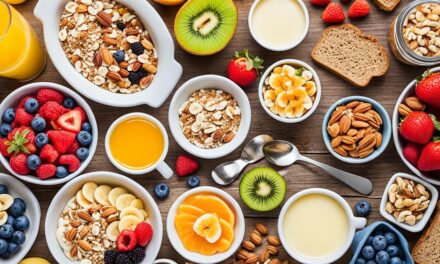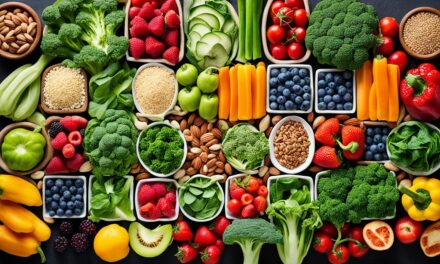Have you ever experienced the frustration of hitting a weight loss plateau? You’re diligently sticking to your diet, exercising regularly, but the scale just won’t budge. It feels like you’ve hit a wall, and it’s disheartening.
Well, what if I told you that there’s a strategy that can help you break through that weight loss stall? It’s called a carb refeed, and it could be the key to rejuvenating your weight loss efforts.
Picture this: You’ve been on a strict low-carb diet for months, cutting out all your favorite foods like pizza, pasta, and bread. You’ve been dedicated and disciplined, but now you’re stuck. The numbers on the scale haven’t changed much, and you’re starting to lose motivation.
But then, a friend tells you about the concept of carb refeeds. They explain that by strategically increasing your carbohydrate intake for a short period of time, you can boost your leptin levels, enhance fat burning, and reignite your weight loss efforts.
It sounds intriguing, doesn’t it? The idea of enjoying a plate of pasta or a slice of cake while still progressing toward your weight loss goals. And the best part is that there’s science backing it up.
So, can you break a weight loss stall with a carb refeed? Let’s dive into the details and find out.
Understanding Adaptive Thermogenesis and its Impact on Weight Loss
When you embark on a weight loss journey, your body’s survival instincts kick in, leading to a phenomenon called adaptive thermogenesis. This process is your body’s way of protecting itself by slowing down your metabolism, making it harder to shed those unwanted pounds. It’s like your body is saying, “Hold on there, let’s conserve energy!”
Adaptive thermogenesis can be frustrating because it feels like your body is working against your weight loss efforts. As your calorie intake decreases, your resting metabolic rate (RMR) also slows down, making it more challenging to burn calories. Additionally, the thermic effect of food, which refers to the energy your body uses to digest and process nutrients, decreases as you reduce your calorie intake.
The reduction in resting metabolic rate and the thermic effect of food has a significant impact on your weight loss journey. It’s like hitting a speed bump on the road to your goals. But fear not, because understanding this process can help you find ways to navigate through it.
One factor that contributes to adaptive thermogenesis is the decrease in leptin levels. Leptin is a hormone produced by your fat cells that plays a crucial role in regulating hunger and satiety signals. When you lose body fat, your leptin levels decrease, resulting in increased hunger and decreased satiety. It’s like your body is telling you, “Hey, we need more energy! Feed me!”
To overcome adaptive thermogenesis and rev up your weight loss efforts, it’s important to understand the impact it has on your body. By finding strategies that work for you, you can outsmart your body’s survival instincts and continue on your path to success.
The Thermic Effect of Food: A Sneaky Culprit
On top of the slowing down of your metabolism, there’s another sneaky culprit that hampers your weight loss progress—the thermic effect of food. This refers to the energy your body uses to digest, absorb, and process the nutrients from the foods you eat.
When you reduce your calorie intake, the thermic effect of food decreases. This means that your body doesn’t burn as many calories during digestion as it did before. So, not only is your metabolism slowing down, but the efficiency of caloric utilization is also decreasing.
Say Goodbye to ‘Slow and Steady’ with Adaptive Thermogenesis
Adaptive thermogenesis can feel like a frustrating roadblock on your weight loss journey. But remember, every challenge is an opportunity to grow. Embrace the science behind it and find ways to work with your body, rather than against it.
Now that you understand the impact of adaptive thermogenesis and the thermic effect of food on your weight loss progress, it’s time to explore strategies that can help you overcome this hurdle. By incorporating targeted approaches like carb refeeds, you can kickstart your metabolism, boost leptin levels, and reignite your body’s fat-burning capabilities.
| Strategy | Description |
|---|---|
| Carb Refeeds | Strategically increasing your carbohydrate intake for a short period to boost leptin levels and enhance fat burning. |
| Calorie Cycling | Alternating between higher and lower calorie intake days to avoid prolonged calorie deficits and prevent adaptive thermogenesis. |
| Strength Training | Building lean muscle mass through resistance training to increase your resting metabolic rate and optimize calorie burning. |
| Adequate Protein Intake | Ensuring you consume enough protein to support muscle growth, satiety, and metabolic function. |
By combining these strategies, you can create a comprehensive approach to combat adaptive thermogenesis, promote a faster metabolism, and achieve sustainable weight loss.
The Role of Carb Refeeds in Breaking a Weight Loss Plateau
Are you stuck in a frustrating fat loss plateau? Don’t worry, there’s a delicious solution – carb refeeds! These strategic periods of increased carbohydrate intake can be a game-changer in your weight loss journey. By boosting leptin levels and manipulating your calorie intake, carb refeeds can help you smash through that stubborn plateau and keep those pounds melting away.
Carb refeeds work their magic by tricking your body into thinking it’s not in a prolonged calorie deficit. This prevents adaptive thermogenesis, that sneaky mechanism that slows down your metabolism. By cycling your carbs, you keep your metabolism revved up like a well-oiled machine, torching fat and banishing those dreaded plateaus.
So how exactly do carb refeeds do it? Well, when you increase your carbohydrate intake, your body releases more leptin – a hormone that regulates hunger and metabolism. This boost in leptin levels stimulates your fat-burning potential and unlocks a whole new level of weight loss. It’s like giving your metabolism a caffeinated jumpstart!
The Science Behind Carb Refeeds
Carb refeeds help combat two major factors that contribute to weight loss plateaus – adaptive thermogenesis and declining leptin levels. When you’re in a calorie deficit over an extended period, your body’s survival instincts kick in, slowing down your metabolism to conserve energy. This is where carb refeeds come to the rescue.
During a carb refeed, your body’s stores of glycogen, the stored form of carbohydrates, get replenished. This sends a signal to your brain that there’s plenty of food available, halting any metabolic slowdown. Plus, the increase in leptin levels signals your body to keep that fat-burning furnace cranked up. It’s a win-win situation!
Timing and Frequency of Carb Refeeds
Now, you might be wondering how often and when to incorporate carb refeeds into your routine. Well, the timing and frequency of carb refeeds may vary depending on factors such as your body fat percentage and gender. But as a general guideline, aiming for a carb refeed every 7-10 days can be a good starting point.
You can experiment with different strategies, like having a high-carb day once a week or every two weeks. Some individuals may benefit from incorporating smaller refeeds more frequently. It’s all about finding what works best for your body and keeps you motivated on your weight loss journey.
Boost Your Fat-Burning with Carb Refeeds
Ready to break free from that weight loss plateau? It’s time to give carb refeeds a try! Remember, carb refeeds are not an excuse to binge on junk food. Focus on quality carbohydrates like whole grains, sweet potatoes, and fruits to maximize the benefits.
Keep an eye on your overall calorie intake during these periods, ensuring you stay within your weight loss goals. And don’t forget to pair your carbs with adequate protein to support muscle growth and repair. With a well-planned carb refeed strategy, you’ll be back on track, torching fat, and hitting your weight loss goals in no time.
Incorporating Carb Refeeds – Tips for Success
Now that you know the role of carb refeeds in breaking a weight loss plateau, let’s dive into some practical tips to make them work for you:
- Gradually increase your carbohydrate intake during a refeed rather than going all out from the start.
- Focus on high glycemic carbohydrates to maximize the leptin-boosting effect. Think rice, bread, pasta, and potatoes.
- Ensure accurate tracking of your food intake during carb refeeds to avoid unintentional overeating or undereating.
- Maintain an adequate protein intake during carb refeeds to support muscle maintenance and satiety.
- Experiment with different refeed frequencies and timings to find the approach that works best for you.
By implementing these tips, you’ll optimize the power of carb refeeds and bid farewell to that weight loss plateau. It’s time to rev up your metabolism, crush those cravings, and achieve the body you’ve been working so hard for!
Implementing Carb Refeeds and Tips for Success
Now that you understand the benefits of carb refeeds in breaking a weight loss plateau, it’s time to put this strategy into action. Implementing carb refeeds effectively requires careful planning and attention to detail. Here are some tips and guidelines to help you succeed:
Increase Carbohydrate Intake
To initiate a carb refeed, you’ll need to increase your carbohydrate intake. Start by doubling your current carbohydrate intake while keeping your fat and protein intake in check. This increase in carbs will help boost leptin levels and signal to your body that it’s not in a prolonged calorie deficit.
Choose High Glycemic Carbs
When selecting carbohydrates for your refeed, opt for high glycemic carbs. These are carbs that are quickly absorbed into the bloodstream, leading to a greater increase in leptin levels. Examples of high glycemic carbs include white rice, white bread, and potatoes.
Track Your Food Intake
During the carb refeed period, it is important to track your food intake accurately. Any errors in tracking can hinder your progress and prevent you from breaking through the plateau. Utilize a food tracking app or journal to ensure you’re consuming the right amount of carbohydrates and staying within your calorie goals.
Maintain Protein Intake
While carbohydrates play a crucial role in carb refeeds, it’s equally important to maintain adequate protein intake. Protein is essential for satiety, muscle maintenance, and repairing tissues. Make sure to include a source of protein in every meal to support your weight loss efforts.
By implementing carb refeeds and following these tips, you can increase the likelihood of breaking through your weight loss plateau and achieving your goals. Remember to stay committed, track your progress, and adjust your refeed guidelines as needed to optimize your results.
Conclusion
So, you’ve hit a weight loss plateau and you’re feeling stuck. Don’t worry – there’s a strategy that can help you break through and continue on your journey to reaching your weight loss goals: carb refeeds. By strategically increasing your carbohydrate intake, you can boost leptin levels, enhance fat burning, and jumpstart your weight loss again.
But here’s the thing – it’s not a one-size-fits-all approach. To maximize the effectiveness of carb refeeds, you need to individualize the timing and frequency based on your specific needs and goals. This means paying attention to your body and finding the right balance that works for you.
When incorporating carb refeeds, remember to choose high glycemic carbohydrates for a greater increase in leptin levels. Track your food intake accurately during this period to ensure you’re on the right track. And don’t forget to maintain adequate protein intake to support satiety and preserve muscle mass.
So, don’t let a weight loss plateau get you down. Break through it with the power of carb refeeds. With the right strategies and determination, you can overcome any obstacles that stand in your way and continue your successful weight loss journey.
FAQ
Can a carb refeed break a weight loss stall?
How can I overcome a weight loss plateau?
What are the benefits of carb refeeds?
How do I implement carb refeeds effectively?
Can carb refeeds be individualized?
MORE SOURCES TO READ:
- https://www.bulknutrients.com.au/blog/weight-loss/how-to-keep-losing-weight-when-fat-loss-stalls
- https://www.bodybuilding.com/content/refeeds-for-fat-loss-the-science-behind-leptin.html
- https://www.alexmaclin.com/blog/breaking-fat-loss-stalls
![]()














Recent Comments